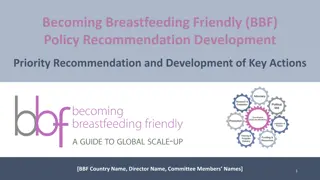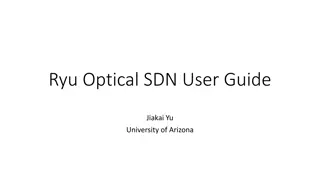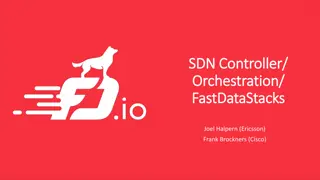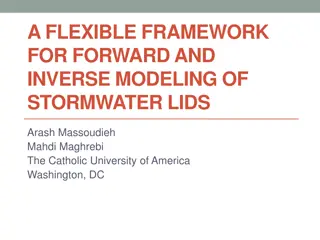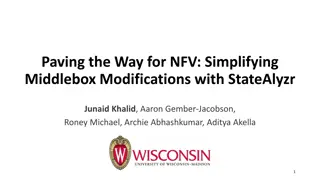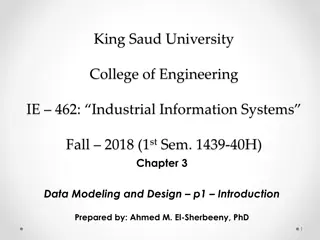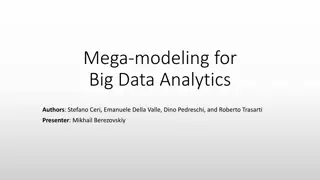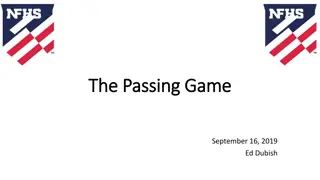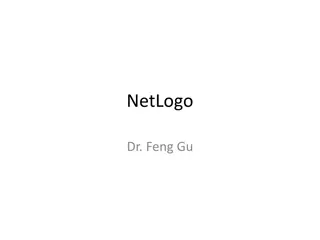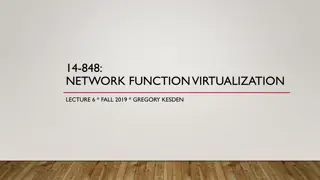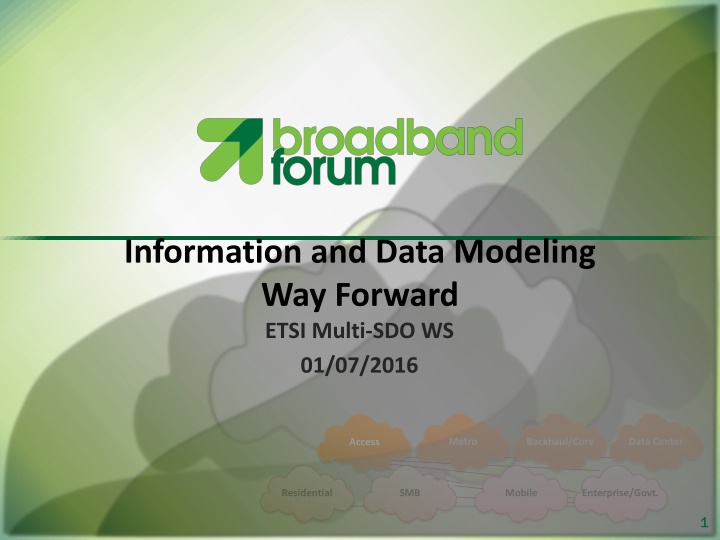
Information and Data Modeling for Enhanced Collaboration Between SDOs and Open Source Communities
Explore the challenges and solutions in coordinating efforts between Standards Development Organizations (SDOs) and Open Source Communities to define a Common Information Model (CIM). The primary objective is to promote light-touch coordination, understand the NFV landscape, and develop a NFV Common Information Model. The approach involves defining domains of interest, seeking niche successes, and demonstrating successful collaboration between SDOs and Open Source Communities.
Download Presentation

Please find below an Image/Link to download the presentation.
The content on the website is provided AS IS for your information and personal use only. It may not be sold, licensed, or shared on other websites without obtaining consent from the author. If you encounter any issues during the download, it is possible that the publisher has removed the file from their server.
You are allowed to download the files provided on this website for personal or commercial use, subject to the condition that they are used lawfully. All files are the property of their respective owners.
The content on the website is provided AS IS for your information and personal use only. It may not be sold, licensed, or shared on other websites without obtaining consent from the author.
E N D
Presentation Transcript
Information and Data Modeling Way Forward ETSI Multi-SDO WS 01/07/2016 Metro Backhaul/Core Data Center Access Residential SMB Mobile Enterprise/Govt. 1 1
Big Picture Situation (main issue leading to this initiative?) Difficulty coordinating between SDOs and Open Source Communities Problem statement We heard: We need to define a Common Information Model (CIM) Sounds like it could be a solution in search of a problem; because of too many unstated assumptions (could there be more stated?) Complications (in the context of an agile world) Open Source Communities and Developers will proceed anyway Need link to market success in the context of an agile world Clarified question How to coordinate efforts and make SDO domain expertise available to Open Source Communities in a format they can use? Recommended approach Define domains of interest Look for a niche success Example that demonstrates SDO and Open Source Community collaboration Succeeds because it s a good idea and creates the conditions for success 2 2
Primary and Secondary Objectives Primary Light touch coordination among the SDOs and Open Source Communities Understand the NFV related information model landscape (including gaps and issues) Understand the work relationships among SDOs and Open Source Communities Secondary Common approaches or aspects to info modeling Development of a NFV Common Information Model 3 3
Light Touch Coordination Minimize impact on Organizations existing and current work Identify and define interaction points Define domains of interest Avoid duplication Encourage re-use Coordination mainly impacts the Core Other Org X and Org Y work is largely unaffected Org X Org Y Exception: when Core functions are re-factored Core Domain X1 Domain Y1 Interaction points 4 4
Information Model Landscape Conceptually a spreadsheet listing NFV-related aspects of each Organization s relevant projects; for example Aspect Description Project Name, Description, Dependencies, Links, Methodology NFV technologies Languages, Tools, Licensing, Interfaces, Entities, Application Areas Network-specific applications, Org relationships Coordination / collaboration relationships, Roadmap Current work plans, likely future work, Known issues Potential overlaps, gaps, sub-optimal relationships, 5 5
Work Relationships Each Organization has its own rules and IPR policy Some work in private (members only) and others in public Some have RAND licensing and others have RAND0 How will Organizations collaborate? Sharing contributions with other Organizations Receiving contributions from other Organizations Special considerations for Open Source Organizations Management and review processes Tools: Mailing lists, Wikis, Issues 6 6
Suggested Next Steps Collaborate to create Information Model Landscape spreadsheet Use this for analysis of gaps, overlaps, issues, relationships etc. 7 7
Thank You! Metro Backhaul/Core Data Center Access Residential SMB Mobile Enterprise/Govt. 8 8
Acronyms AAA Authentication, Authorization and Accounting ACS Auto-Configuration Server (TR-069) AN Access Node API Application Programming Interface BB - BroadBand BBF Broadband Forum BCP Best Current Practice BPCF Broadband Policy Control Function BNG Broadband Network Gateway BRG Bridged RG BSG Broadband Service Gateway BSS Business Support Systems CPE Customer Premises Equipment DC Data Center DHCP Dynamic Host Configuration Protocol DM Data Model DT Device Type EM Enterprise Management FAP Femtocell Access Point FTTdp Fiber To The Distribution Point FW Firewall GW Gateway HTML HyperText Markup Language IP Internet Protocol IPR Intellectual Property Rights LSL Logical Subscriber Link MSBN Multi-Service Broadband Network MS-BNG Multi-Service BNG NAS Network-Attached Storage NAT Network Address Translation NERG Network Enhanced Residential Gateway NFV Network Function Virtualization NFVI NFV Infrastructure OAM Operations, Administration and Management OSS Operations Support Systems PCRF Policy and Charging Rules Function PDF Portable Document Format PON Passive Optical Networking RG Residential Gateway SAG Software Advisory Group SDN Software-Defined Networking SMB Small/Medium Business STB Set Top Box UML Unified Modeling Language VBG Virtual Business Gateway VoIP Voice over IP vCGNAT Virtual Carrier Grade NAT vBNG Virtual BNG vG Virtual Gateway XML eXtensible Markup Language 9 9
Standardization Landscape TMForum ETSI NFV BBF/3GPP/ BBF/3GPP/ IETF IETF ONF, ETSI, IETF ONF, ETSI, IETF Derived from bbf2015.411 Reference Architecture Revisions 10 10
Information Model Landscape The Core has to be widely applicable Implies information modeling (rather than data modeling) Hence Core / Common Information Model (CIM) Must consider the relevant layer for each interaction point Also consider the modeling approach at that layer Interaction should impact only this layer Core Domain Y1 Domain X1 11 11
Information Model Landscape: Example G.fast YANG module based on IETF RFC 7223 A YANG Data Model for Interface Management Need to map RFC 7223 interfaces to/from CIM interfaces CIM needs to support NETCONF/YANG config/state separation? Firewall NF defines rules referencing layer 1, 2 or 3 interfaces Need to map these interfaces to/from CIM interfaces CIM Firewall NF G.fast YANG 12 12
YANG Best Current Practices Domain of expertise is independent; like another dimension RFC 6020 (YANG) and RFC 6087 (Guidelines) IETF YANG BBF YANG BCPs RFC 7223 (Interfaces) etc. Additional BBF-specific rules Common SDO YANG BCPs Additional SDO X and Y rules IETF YANG BCPs YANG that is directly useful to IETF, BBF, SDO X and SDO Y needs to follow the Common SDO YANG BCPs SDO X YANG BCPs SDO Y YANG BCPs The same principle applies to information modeling 13 13







